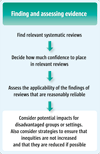SUPPORT Tools for evidence-informed health Policymaking (STP) 10: Taking equity into consideration when assessing the findings of a systematic review
- PMID: 20018100
- PMCID: PMC3271821
- DOI: 10.1186/1478-4505-7-S1-S10
SUPPORT Tools for evidence-informed health Policymaking (STP) 10: Taking equity into consideration when assessing the findings of a systematic review
Abstract
This article is part of a series written for people responsible for making decisions about health policies and programmes and for those who support these decision makers. In this article we address considerations of equity. Inequities can be defined as "differences in health which are not only unnecessary and avoidable but, in addition, are considered unfair and unjust". These have been well documented in relation to social and economic factors. Policies or programmes that are effective can improve the overall health of a population. However, the impact of such policies and programmes on inequities may vary: they may have no impact on inequities, they may reduce inequities, or they may exacerbate them, regardless of their overall effects on population health. We suggest four questions that can be considered when using research evidence to inform considerations of the potential impact a policy or programme option is likely to have on disadvantaged groups, and on equity in a specific setting. These are: 1. Which groups or settings are likely to be disadvantaged in relation to the option being considered? 2. Are there plausible reasons for anticipating differences in the relative effectiveness of the option for disadvantaged groups or settings? 3. Are there likely to be different baseline conditions across groups or settings such that that the absolute effectiveness of the option would be different, and the problem more or less important, for disadvantaged groups or settings? 4. Are there important considerations that should be made when implementing the option in order to ensure that inequities are reduced, if possible, and that they are not increased?
Figures
References
-
- Marmot M. Social determinants of health inequalities. Lancet. 2005;365:1099–104. - PubMed
LinkOut - more resources
Full Text Sources
Molecular Biology Databases




